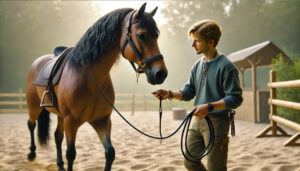
Welcome to Hoof Beats U or welcome back if this isn’t your first time! Today, we’re diving into the basics of horse training: teaching your horse the fundamental commands of walk, stop, and turn. These commands are the building blocks of effective communication and control, setting the stage for more advanced training. Let’s get started!
Why Basic Commands Matter
Before we jump into the how-tos, it’s essential to understand why these basic commands are crucial. Teaching your horse to walk, stop, and turn on command is not just about obedience. It’s about creating a foundation of trust and clear communication. When your horse understands and responds to these basic commands, it makes everything from daily handling to advanced training much smoother and safer for both of you.
Getting Started: Establishing a Connection
Before you begin training, spend some quality time with your horse. Building a strong bond is the key to successful training. Spend time grooming, talking, and just being around your horse. This helps your horse feel more comfortable and trusting, which is vital when introducing new commands.
Command 1: Walk
Step-by-Step Guide
- Preparation:
-
- Equip your horse with a halter and lead rope.
- Stand on the left side of your horse, holding the lead rope in your right hand, about 12 inches from the halter.
- Giving the Command:
-
- Use a clear, firm voice to say “walk.”
- Simultaneously, apply gentle pressure forward with the lead rope and take a step forward yourself.
- Positive Reinforcement:
-
- As soon as your horse starts to walk, release the pressure on the lead rope slightly to signal they’re doing the right thing.
- Praise your horse with a gentle pat and a calm voice saying, “Good walk.”
- Practice:
-
- Repeat this process several times in short sessions.
- Consistency is key. Keep your commands and actions the same each time.
Tips for Success
- Be patient. Horses may take time to understand what you’re asking.
- Always reward progress, no matter how small.
- If your horse doesn’t respond, try slightly increasing the pressure on the lead rope.
Command 2: Stop
Step-by-Step Guide
- Preparation:
-
- Start with your horse walking calmly beside you.
- Giving the Command:
-
- Use a clear, firm voice to say “stop.”
- At the same time, stop walking and apply backward pressure on the lead rope.
- Positive Reinforcement:
-
- As soon as your horse stops, release the pressure on the lead rope to signal they’ve done the right thing.
- Praise your horse with a gentle pat and a calm voice saying, “Good stop.”
- Practice:
-
- Repeat this process in short, frequent sessions.
- Practice stopping from different speeds to ensure your horse understands the command in various contexts.
Tips for Success
- Make sure your stop command is clear and distinct from your other commands.
- Be consistent with your timing when applying and releasing pressure.
- Use your body language to reinforce the command by standing still and facing slightly towards your horse.
Command 3: Turn
Step-by-Step Guide
- Preparation:
-
- Start with your horse standing calmly beside you.
- Giving the Command:
-
- Use a clear, firm voice to say “turn.”
- For a right turn, move your body to the right and apply gentle pressure on the lead rope to guide your horse’s head in that direction.
- For a left turn, do the opposite: move to the left and guide your horse’s head with the lead rope.
- Positive Reinforcement:
-
- As soon as your horse begins to turn, release the pressure on the lead rope slightly.
- Praise your horse with a gentle pat and a calm voice saying, “Good turn.”
- Practice:
-
- Repeat turning in both directions in short, frequent sessions.
- Vary the sharpness of the turns to help your horse become more responsive.
Tips for Success
- Use your body language to lead the turn. Your horse will follow your movement.
- Start with gentle turns and gradually increase the sharpness as your horse becomes more comfortable.
- Be patient and consistent with your commands and actions.
Troubleshooting Common Issues
Horse Not Responding:
- Ensure your commands are clear and consistent.
- Check that you’re using the correct amount of pressure on the lead rope.
- Spend more time bonding with your horse to build trust and responsiveness.
Horse Stopping Too Slowly:
- Practice stopping from different speeds and distances.
- Reinforce the command by using your voice and body language together.
Horse Turning Too Widely:
- Start with smaller, more controlled turns.
- Use your body to guide the turn more effectively.
Conclusion
Teaching your horse to walk, stop, and turn on command is a fundamental part of training that sets the stage for more advanced skills. Remember, patience and consistency are your best tools. Celebrate the small victories and keep building on the trust and communication between you and your horse. Happy training!



